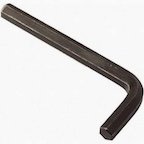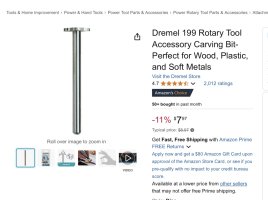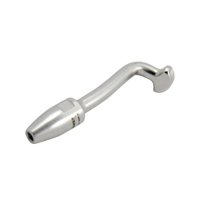Wow, you get quite a bit of core removed. What tool do you use? I'm using a dremel with a 5/16 rotary carving bit (https://www.amazon.com/Dremel-115HP...ocphy=9033382&hvtargid=pla-2281435180458&th=1)
Guest viewing is limited
- You have a limited number of page views remaining
- 8 guest views remaining
- Register now to remove this limitation
You are using an out of date browser. It may not display this or other websites correctly.
You should upgrade or use an alternative browser.
You should upgrade or use an alternative browser.
Standing rigging estimates?
- Thread starter Kif
- Start date
I have found that a right-angle piece like a bent nail or better yet an allen wrench works best. Shorten the end to suit the cutback you desire - on a grinder. I used this idea for well over a hundred holes in our deck during prep for painting. This was a vital part of the process of epoxy-filling and redialing all the bolt holes.What tool do you use?
Thanks to Bryan for the excellent photos !
Attachments
Aye, same tool. The holes weren't drilled very cleanly during production, so grinding from the bottom where the opening is bigger allowed more material removalWow, you get quite a bit of core removed. What tool do you use? I'm using a dremel with a 5/16 rotary carving bit (https://www.amazon.com/Dremel-115HP...ocphy=9033382&hvtargid=pla-2281435180458&th=1)
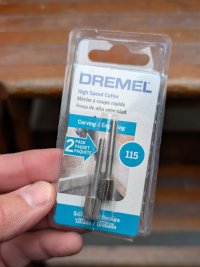
Thanks, Ken! I'm buying one of those right now for future use 
Lot's of good conversation here and good advice. We are in the process of replacing all of the U-bolts since two of them have failed. We will probably replace the remainder of the standing rigging too. The backstay and chainplate was replaced last year and the forestay this year when we replaced the roller ruler.
I haven't seen mentioned (unless I missed it) the swaged t-ball fitting on the mast end of the shrouds. Has anyone had issues - corrosion/deterioration on the mast itself where the shrouds are attached? Has anyone used swagless T-ball fittings?
I haven't seen mentioned (unless I missed it) the swaged t-ball fitting on the mast end of the shrouds. Has anyone had issues - corrosion/deterioration on the mast itself where the shrouds are attached? Has anyone used swagless T-ball fittings?
The t-ball terminals in the mast are stainless steel inserts held in place by four rivets. Would be hard to inspect from the inside (would need an endoscope), but you can get a general feel for their condition from outside the mast. The t-fitting doesn't move inside the terminal once tightened, so I'd guess there's very little wear on the terminal.Has anyone had issues - corrosion/deterioration on the mast itself where the shrouds are attached? Has anyone used swagless T-ball fittings?
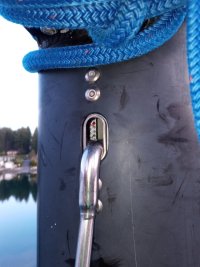
I added plugs to mine to try to reduce the water that gets into the mast (Seattle rains....)
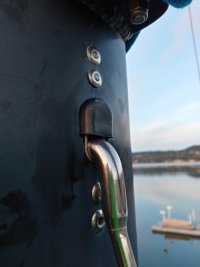
I haven't heard of swageless T-balls. How do they connect to the wire?
Wow! Looks like Port Annapolis got ya . What model is your Ericson?Just to give you an estimate on the far upper end of doing a job like this, I had my mast taken down last year and completely overhauled That included just about everything except for the mast itself, the spreaders and repainting but did include cleaning up some corrosion. New sheaves, wiring, standing rigging, fasteners, turnbuckles, halyards, anchor light, steaming/fore deck light, etc., etc. Since I'm in my 70s, live 2 hours from the marina and had only a small knowledge of serous rigging work I had the refit done professionally. The final price came to about $17k. Just the labor costs were $5,000. That's right, but I wanted a top notch professional job that I could rely on without worry. Not saying that this sort of major rigging project could not be done by an owner, I just didn't feel qualified to tackle something that I needed to depend on for my well being.
Here's a short video of the mast removal if you're interested.
Looks like a 32-3 or 32-200?Wow! Looks like Port Annapolis got ya . What model is your Ericson?
That's the condition I am concerned about.
Bolo
Contributing Partner
An E32-3. They "got me"? As in I paid too much? Not in my opinion. They did a top notch job with inspection, execution and following up with another inspection where a few minor things were deemed to be OK but not quite right and then fixed. How much of a price do you put on the safety of you and your crew? Just look at what they just found on Christian's boat and no one can say that he's a sailor with limited experience or lack of vigilance when it comes to rigging. Plus, I'm a sailor in his 70s and although I am quite active because I'm in good health I'm not keen on going up on the mast. No, I don't think they "got me" because when I've gone out in a big blow and a challenging chop on the bay I feel more confident about the rigging and in turn enjoy sailing more.Wow! Looks like Port Annapolis got ya . What model is your Ericson?
Pete the Cat
Sustaining Member
The opinion of the guys in my boatyard is that properly prepped (end fibers sealed with wet epoxy)and installed end grain balsa is better for preventing water intrusion than plywood. Plywood is easier to install and has some small inherent strength advantage, but is much more subject to water intrusion from flexing and swelling that creates lateral gaps. Production builders use plywood because it is cheap and fast to install. Plywood is better for compression loads when external backing plates are used. On the more custom boats like Hinckleys and Tartans you will find solid fiberglass at stanchion and chain plate deck penetrations. I would recommend "drill and fill" thickened epoxy for any of these holes with plywood showing if you have gone this far.Definitely plywood around the chain plates on my E32-3. Plywood is nice because it degrades so much more slowly when compared to balsa. Even with some water intrusion, the core was in good shape. Here's a couple photos before and after grinding back the core for epoxy:
View attachment 52264. View attachment 52263
Agree. I did that with the plywood coring under our traveler on the bridge deck, and under the binnacle where the aft cockpit sole was plywood cored. The "carving out" of the coring was a little more involved.I would recommend "drill and fill" thickened epoxy for any of these holes with plywood showing if you have gone this far.
It was tongue-in-cheek, but I am quite amazed at the price tag nonetheless. That's basically half the price of what a nice 32-3 costs--especially in this economy where boats are starting to sit for years!An E32-3. They "got me"? As in I paid too much? Not in my opinion. They did a top notch job with inspection, execution and following up with another inspection where a few minor things were deemed to be OK but not quite right and then fixed. How much of a price do you put on the safety of you and your crew? Just look at what they just found on Christian's boat and no one can say that he's a sailor with limited experience or lack of vigilance when it comes to rigging. Plus, I'm a sailor in his 70s and although I am quite active because I'm in good health I'm not keen on going up on the mast. No, I don't think they "got me" because when I've gone out in a big blow and a challenging chop on the bay I feel more confident about the rigging and in turn enjoy sailing more.
For 17K (or a little more), I would hope to buy a new mast and all new rigging. Last time I re-rigged a boat was in 2019 and it was an 1987 Ericson 38-200 in Southwest Florida. It cost me about $2,100 for all new wire and swaged fittings and the rigger did the work in the yard on the ground. I believe he was supplied by Hayn and he made everything on-site, in his work van. He also came to the boat after to tension the rig in the water.
For what it's worth, I ran a mobile marine repair business (including some sailboats) in the Annapolis area for three years from 2021-2024 and charged $145/hour by the end, so I do think I have a handle on how much things can and should cost in this area.
I will restate that 17K is a very hefty sum for this type work, depending on how exhaustive. My bet is that yards to the south and north of Annapolis like Herrington Harbor would do it for substantially less--I bet even Jabin would have been much less since they have competition between contractors. I push back because I think you paid much above the going rate and I don't want it to scare other Ericson owners from doing this type of work--even those in the Annapolis area.
Did that price include painting I hope? Did it include removing and rebedding chainplates?--which is the real weakness on Ericsons (I know because I broke one on passage that could have taken the rig with it had I not caught it).
But hey, it's your boat and your money and if you got it and don't mind dishing it out, then I can see how one would be happy with having such work done for him, no matter the cost: you can't put a price on peace of mind. I'm glad it worked out for you and that you're happy with the work at Port Annapolis! It is a nice marina and I almost kept (and lived on) another Ericson there in 2022.
I think the real "they got you" moment is when you write the check to buy the boat. After that, you have only 3 choices; spend a whole lotta your own time to keep the boat up, spend a whole lotta $, or let the boat rot.
There is still a high "real" cost to any of the 3 choices. Worse, since you never get back the money or time you pour into a boat, option C is likely the best financial return on your money.
And yet, here we are....
Analyzing boat ownership from a financial perspective (unless you're running it as a business) never adds up.
There is still a high "real" cost to any of the 3 choices. Worse, since you never get back the money or time you pour into a boat, option C is likely the best financial return on your money.
And yet, here we are....
Analyzing boat ownership from a financial perspective (unless you're running it as a business) never adds up.
Last edited:
I will restate that 17K is a very hefty sum for this type work
Only if you can't afford it.
Only if you can't afford it.
I will restate that 17K is a very hefty sum for this type work
Only if you can't afford it.
It is indeed all relative for sure: I had some clients who would balk at an extra $17 and others who wouldn't bat an eye at an extra $1,700.
Bolo
Contributing Partner
So true, Williams, so true.I will restate that 17K is a very hefty sum for this type work
Only if you can't afford it.
Last edited:

